中国文化与翻译2全解共73页
中国文化和汉英翻译
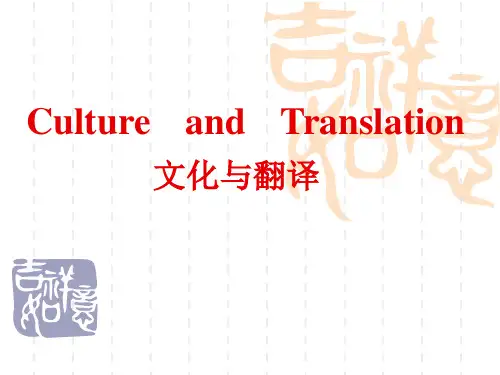
Definition Four
In 1871 E.B. Taylor defined culture as "that complex whole which includes knowledge, belief, art, morals, law, customs, and many other capabilities and habits acquired by members of society." "Culture means the total body of tradition borne by a society and transmitted from generation to generation. It thus refers to the norms, values, standards by which people act, and it includes the ways distinctive in each society of ordering the world and rendering it intelligible. Culture is...a set of mechanisms for survival, but it provides us also with a definition of reality. It is the matrix into which we are born, it is the anvil upon which our persons and destinies are forged."
Culture and Translation
文化与翻译
It is not easy to give a clear definition about culture. There are various definitions about it.
《传统文化与翻译》课件
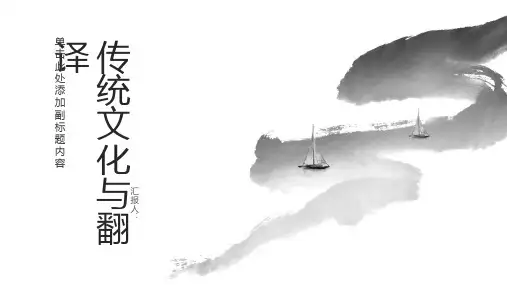
语言差异:不同 文化背景下的语 言表达方式不同, 需要翻译者理解 并转换
历史背景:不同 文化背景下的历 史事件和历不同 文化背景下的社 会习俗和价值观, 需要翻译者理解 和尊重
宗教信仰:不同 文化背景下的宗 教信仰和禁忌, 需要翻译者了解 和避免冒犯
翻译中文化背景的处理方法
践案 例 分 析 与 实
经典案例分析
案例一:《红楼梦》的翻译 案例二:《西游记》的翻译 案例三:《三国演义》的翻译 案例四:《水浒传》的翻译 案例五:《金瓶梅》的翻译 案例六:《聊斋志异》的翻译
实践经验分享
翻译过程中,要注意文化差异,避免误解 翻译时,要尊重原文,保持原文的韵味和内涵 翻译时,要注意语言的准确性和流畅性 翻译时,要注意语言的简洁性和通俗性,便于读者理解
拟人:将事物赋予人的情感、行为或特征,如“春风又绿江南岸”
夸张:夸大事物的特征或程度,如“飞流直下三千尺” 对仗:上下句或词组在结构、音韵、意义等方面相互对应,如“两个黄鹂鸣翠柳,一行白鹭上青 天”
传统文化中的词汇含义
成语:简洁明了, 寓意深刻
谚语:通俗易懂, 富有哲理
典故:历史故事, 寓意深刻
诗词:优美典雅, 寓意深远
翻译传统艺术:如京剧、昆曲等
翻译传统医学:如中医、针灸等
化翻 的译 创中 新传
统 文
传统文化的创新需求
传统文化的传承与 保护
传统文化与现代文 化的融合
传统文化的创新与 传播
传统文化的创新与 国际交流
翻译中传统文化的创新方式
保留原文风格:在翻译过程中保留原文的风格和特点,使译文具有原文的韵味和特色。
实际操作技巧
翻译前,了解原文 的文化背景和语言 特点
翻译时,注意保持 原文的语境和情感 色彩
传统文化与翻译课件
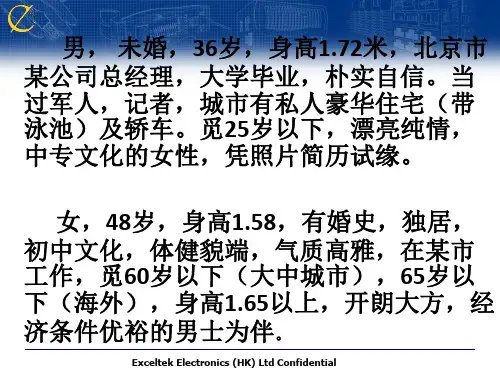
S/F, 31, 5’6’’, blonde and tan! Seeking sun loving male, 26-42. Must be affectionate, honest, caring. But also can get wild and crazy! Interests: Romantic weekends, beaches, fishing, camping, cuddling, auto races, barbecues, flea markets. Enjoy summer activities? Pick up that pen and write!! Photo and phone number.
Exceltek Electronics (HK) Ltd Confidential
每个民族由于自己的历史传统,地理和社会环境等,形成了 自己特有的文化。
文化是一种复杂体,它包括知识,信仰,艺术,道德,法律, 风俗,以及其余社会上习得的能力与习惯------人类学家泰勒
Exceltek Electronics (HK) Ltd Confidential
Exceltek Electronics (HK) Ltd Confidential
一见面是寒暄,寒暄之后说我“胖了”,说我“胖了”之后 即大骂其新党。(鲁迅《祝福》)
When we met, after exchanging a few polite remarks, he said I was fatter, and after saying that he immediately started a violent attack on the revolutionaries.
中国文化与翻译-课件2-Chinese Culture and Translation
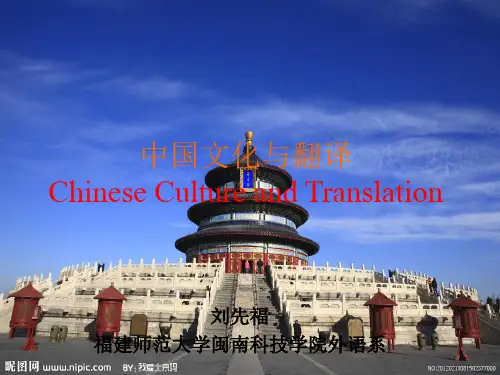
第二章 中国文化在汉英翻译中的 再现
• 第一节 翻译的基本方法 • 【词法翻译】 • 一 对等译法 • 在翻译过程中,我们一般都可以在译文语言中找到同原文中 某个单词、词组或成语意义上的对等表达。 • (一)单词 • Television (n) 电视 • Electricity (n) 电 • Wheat (n) 小麦 • 坐 (v) sit • 小 (adj.) small • 和 (conj.) and
• 2. 再如,中国古老的文明源于黄河中下游的 中原地带,人们以农耕为主,牛是与汉民族联 系最紧密的动物。这种密切的联系反映到语言 中就是汉语中有众多围绕“牛”这个字的词语, 如:“牛皮、牛马、牛性、牛劲、吹牛、牛角 尖、老黄牛、牛脾气、牛郎织女、牛刀小试、 对牛弹琴、庖丁解牛”等等。而西方则源于游 牧文化,与马的关系非常密切,对该文化而言, 牛只是用来产奶的动物,即使耕地,西方也以 用马为主。这样,英语中就形成了与汉语中的 “牛”的系列词语相对应的“马”(horse)的 系列词语,如:to talk horse 吹牛, to work like a horse 像老黄牛一样拼命干活,as strong as a horse 力大如牛, a willing horse, 工作认真的 人,
•
这一定义显然排除了物质文明发展水平的 高低,而是指人类的精神文明或精神成果的总 和,包括艺术、传统、习惯、社会风俗、道德 伦理、法的观念和社会关系等。 • 据上所述,不管是广义的文化还是狭义的 文化部包括许多方面。所谓翻译,无非是通过 一种语言转达另一语言的文化信息,因此可以 说任何翻译都离不开文化。历来有经验的译者 或翻译研究者都比较注意文化与翻译的关系。 王佐良说:“……翻译者必须是一个真正意义 的文化人。人们全说:他必须掌握两种语言, 确实如此;但是,不了解语言当中的社会文化, 谁也无法真正掌握语言。”(《翻译中的文化 比较》, 1984.1.《翻译通讯》)。
中国文化与翻译2
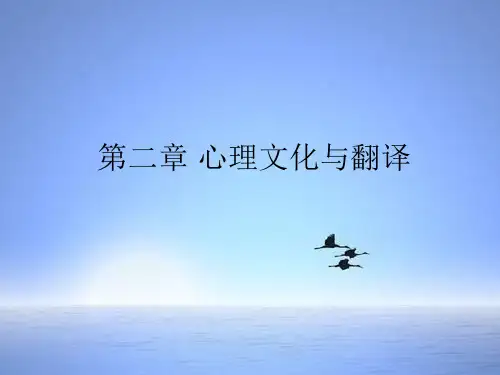
一、重复结构
汉语喜欢重复,英语崇尚简洁,这是汉 英民族审美心理差异所形成的不同的审美标 准,翻译时对于汉语的重复词语或重复结构 必须有所删削省略,以使译文适应读者的审 美心理,符合英语的表达习惯。
保守的 维持原状、不求 上进;跟不上形势的 发展《现代汉语词 典》;因循守旧 、安 于现状、不思进取
conservative 1. resistant to change 2. opposed to liberal reforms 3. avoiding excess 4. unimaginatively conventional 5. conforming to the standards and conventions of the middle class
自谦心理的表现
(1)工作中取得成绩,被表扬,获得荣誉称号 时的言语回应:“离领导的要求还相差很远,今后 还要继续努力”、“还有许多不足之处,请大家以 后多多关照”、“哪里,哪里,主要靠领导关心, 靠大伙儿帮忙”。 (2)汉语中大量的谦称词语:称呼自己,敝人、 小人、下官;称呼自己的妻子,拙荆、贱内;称自 己的子女,小女、犬子;称自己的寓所,寒舍、舍 下;称自己的作品和文章:拙著、拙作;称自己送 别人的礼物,薄礼;称招待客人的酒席,薄酒,家 常便饭、粗茶淡饭;自己的意见和建议,浅见、拙 见。
例1. “但是,你这些想法和作法,恐怕还是 为了你个人吧?” 道静蓦地站了起来:“你说我是个人主义 者?” “Are you sure your thoughts and wishes aren’t determined by personal considerations?” he asked. Daojing sprang to her feet. “Do you mean that I’m an individualist (egoist)?” egoism ['i:ɡəuizəm] n. 1. (ethics) the theory that the pursuit of your own welfare on the basis of morality 2. concern for your own interests and welfare
文化与翻译 ppt课件
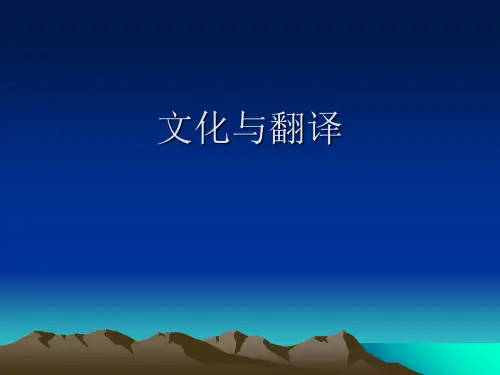
汉语和英语中都有大量成语短语,喻义相同但所采用 的喻体迥异,其原因也都是由于不同的文体习俗所 引起的不同的语义联想所决定的。
一箭双雕 to kill two birds with one stone 杀鸡取卵 to kill the goose that lays the golden
eggs 害群之马 black sheep 爱屋及乌 love me, love my dog 本末倒置 to put the cart before the horse 掌上明珠 apple of the eye
(赵辛楣)一肚皮的酒,几乎全化成酸醋…
(钱钟书:《围城》)
The wine in Xinmei‘s stomach turned to sour vinegar in his jealousy.
西方人无法理解“醋”在中国文化中的含义,故在 译文中增译“in his jealousy”,便于英语国家读者理 解句子的隐含之义
我属鸡。我从来不吃鸡,鸡年是我的本命年。
I was born in the Year of the Rooster. I never eat chicken. The Year of the Rooster will bring me good luck or bad luck.
(Chinese people traditionally use 12 animals, representing the 12 Earthly Branchese, to symbolize the year in which a person is born. Spring festival 1993, for example, is the first day of the year of the rooster. People born in this year have the rooster as their life symbol. All other years of the rooster, according to an old Chinese saying, become either good-orbad-luck years for them.)
中国文化概况翻译(2)
翻译:一、The consti tutio n of the people’srepubl ic of chinais the fundam ental law of the state.中华人民共和国宪法是中国的根本法。
The NPC is the highes t organof statepower. Localpeople’scongre ssesare localorgans of statepower.The standi ng commit tee of the NPC is the perman ent organof the NPC. The term of office of the NPC and its standi ng commit tee is 5 years.The NPC and its standi ng commit tee are empowe red with the rights of legisl ation, decisi on, superv ision, electi on and remova l.全国人民代表大会是最高国家权力机关。
地方各级人民代表大会是地方权力机关。
全国人民代表大会常务委员会是全国人大的常设机关。
全国人大及其常委会任期是五年。
全国人大及其常委会有立法,决策,监督,选举和罢免的权力。
The commun ist partyis the sole partyin powerin china.Apartfrom it, thereare eightdemocr aticpartie s in china.Multi-partycooper ation and politi cal consul tatio n underthe leader shipof the CPC is the basicpoliti cal system in china.共产党是中国唯一的执政党。
四六级中国文化翻译 2
翻译练习1.春节是是中国的农历新年。
在中国的传统节日中,这是一个最重要、最热闹的节日。
中国人过春节有很多传统习俗。
除夕之夜,是家人团聚的时候。
一家人围坐在一起,吃一顿丰盛的年夜饭(New Year’s Eve dinner),说说笑笑,直到天亮,这叫守岁(staying up to see the year out)。
除夕零点的钟声一响,人们还要吃饺子。
从初一开始,人们要走亲戚、看朋友,互相拜年(greet each other)。
拜年,是春节的重要习俗。
放爆竹(set off firecrackers)是春节期间孩子们最喜欢的活动。
传说燃放爆竹可以驱妖除魔(drive off evil spirits)。
2.农历八月十五(the 15th day of the eighth lunar month),是中国的传统节日中秋节(Mid-Autumn Festival)。
这天晚上,天上的月亮又圆又亮。
人们把圆月看作团圆美满的象征,所以中秋节又被称为“团圆节”( Festival for Reunion)。
按照传统习惯,中国人要一边赏月(admire the moon) 一边品尝月饼。
因为月饼是圆的,象征着团圆,所以有的地方叫它“团圆饼”。
秋天,人们一年的劳动有了收获。
中秋节的晚上,全家人坐在一起赏月、吃月饼,心里充满了丰收(bumper harvest) 的喜悦和团聚的欢乐。
这时,远离家乡的人们也会仰望明月,思念故乡和亲人。
3.英语中的“china”一词有两个意义,一个是中国,一个是瓷(porcelain)。
西方人很早就把中国与瓷器联系在一起,这是因为瓷器是中国人发明的。
瓷器是从陶器(pottery) 发展来的,如果从生产原始瓷器的商代(Shang Dynasty)算起,中国的瓷器大约有三千多年的历史了。
江西景德镇被称为中国的“瓷都”(the Capital of Porcelain)。
中国瓷器不仅是精美的日用品,也是珍贵的艺术品。
(完整word版)新时代交互英语读写译2-中国文化翻译(中英对照)
Unit 1 Book 3中国传统节日中国传统节日以中国的农历为依据。
农历年的岁首称为春节,俗称“过年”,有祈年等多种习俗,是中国人民最隆重的传统节日,象征团结兴旺。
其他主要的节日有元宵节、清明节、端午节、七夕节、中秋节、重阳节、冬至节、腊八节等等.各个节日都有其来源讲究和风俗习惯。
农历节日与农历中的二十四节气不同。
农历节日是中华民族凝聚力与生命力的体现.Traditional Chinese FestivalsTraditional Chinese festivals are usually fixed according to the lunar calendar. January 1st on lunar calendar has been designated as the Spring Festival (generally referred to as guonian). There are several customs during the Spring Festival, such as praying for a good harvest, etc. The Spring Festival is the most ceremonious traditional festival in China and symbolizes unity and prosperity。
Some other significant Chinese festivals include the Lantern Festival, the Pure Bright Festival, the Dragon Boat Festival, the Double—seventh Festival, the Mid-Autumn Festival, the Double-Ninth Festival, the Winter Solstice, and the Eighth Day of the Twelfth Lunar Month, etc. Each festival has its own unique origin and custom. These Chinese festivals that follow the lunar calendar are different from the 24 Solar Terms in the lunar calendar. They embody China's cohesion and vitality.Unit 3 Book 3中国画中国古代四大艺术“琴棋书画”的“画”特指国画。
文化,语言,翻译全文-大学课件-
· 44.1..11词. 英汇语差中异动词-各较种少词,性汉的使语用中频动率词不较同多
· 天已经擦黑,虫鸣蛙噪,一片喧闹。
· I t i s already dark, and the chorus of insects and frogs i s in f u l l swing.
· 看来我们免不了要碰上一场暴风雨了。
· The many colors of a rainbow range from red on the outside to violet on the
inside.
· 彩虹有多种颜色,外圈红,内圈紫。
· Awomanwith f a i r opportunities, and without
类。 · 句子要素,主语、谓语、宾语、定语、状语
等的划分。
√ Asynthetic language i s “characterized by frequent and systematic use of inflected forms to express grammatical relationships”.
an absolute hump, may marry whomshe likes.
· 译文:一个女人只要有机会好,又不是很驼背, 想嫁给谁都行。
· Carlisle street runs westward, across a great black bridge, downa h i l l and up again, by l i t t l e shops and meat-markets, past singlestoried homes, until suddenly i t stops against a wide green lawn.
